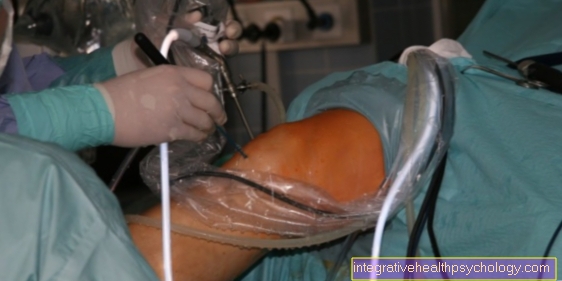Operation of xanthelasma
General
Since xanthelasma and xanthomas can be an indication of excessively high fat values, the blood fat values should always be examined before the xanthelasma is then removed for cosmetic reasons.
If the blood values of cholesterol or triglycerides are high, normalization should be aimed for. The so-called xanthomas then often disappear on their own as soon as the metabolism has normalized and the blood lipid levels are also normal again.
If the xanthelasma persists, they can be surgically removed or removed using other methods (e.g. laser).

Surgical methods
There are several methods to choose from to perform the surgical removal of the xanthelasma:
- Surgical excision
- Electrocautery
- CO2 laser, erbium laser ablation
- cryosurgery
- Argon, dye, KTP lasers
- Trichloroacetic acid treatment
After the xanthelasma has been removed, 40-60% of the patients develop new xanthelasma (relapses). For this reason, the surgical procedure for xanthelasma is usually not very useful and should only be carried out if an aesthetic operation such as an eyelid lift is planned in parallel anyway.
General
If there is a hard deposit of fat, it can sometimes be scratched and then removed by squeezing it out, but soft fat deposits must always be treated differently.
Treatment with argon laser has long been the preferred therapy for xanthelasma and after two laser sessions the fat deposit was successfully treated. Dye lasers are particularly suitable for flat xanthelasma, but several sessions are necessary and increased hematomas (bruises) can be expected.
According to various studies, erbium and CO2 lasers are very effective against xanthelasma, cause only mild side effects and rarely relapse of xanthelasma.
In general, no standard procedures can be named, but a decision has to be made from patient to patient which procedure is individually most suitable for the treatment of xanthelasma. The treating dermatologist can choose from the various therapy options what is most suitable for the individual patient and his or her nature of the xanthelasma.
An operation in the classic sense is now rarely necessary, but the xanthelasma can be removed in the most gentle way with the help of the laser.
The costs of the procedure are covered by private health insurances, but the statutory health insurance does not cover any aesthetic procedures, so the person affected has to finance the procedure himself. Costs from 250 € can be expected, but the exact costs vary as they depend on the size, number of xanthelasma and the selected therapy method.
What are the risks of an operation?
The xanthelasma operation is a low-risk procedure. An operation can leave a scar. If the xanthelasma is removed with a laser, there is a risk of subsequent bruising or pigment changes. With all methods there is also a risk that the xanthelasma will recur.
Who operates on xanthelasma?
Xanthelasma can be operated on by doctors of various specialties. These include ophthalmologists, plastic surgeons and dermatologists (dermatologists). It is advisable to find out beforehand which doctor offers which methods. Your treating doctor will recommend the most suitable method for you and explain the advantages and disadvantages of the various methods.
What does the operation cost?
There is no one-size-fits-all answer to what an operation costs. The cost depends on the method chosen, as well as the size and number of the xanthelasma. As a rule, you can expect costs of 250 euros upwards. It is advisable to obtain a cost estimate from the attending physician.
Does the health insurance company bear the costs?
The removal of xanthelasma is usually a purely cosmetic procedure. For this reason, statutory health insurance usually does not pay for an operation or removal using any other method (e.g. laser). In the case of private insurance, you should ask whether and which services are covered.
If there is an underlying disease, such as a lipid metabolism disorder, the treatment will be covered by health insurance companies.
How long does the operation take?
How long an operation to remove xanthelasma cannot be given in general terms, as the duration depends largely on the treatment method chosen.You should plan the time for the preparation and follow-up work and the procedure itself. As a rule, you can expect a treatment duration of 15 to 30 minutes.





























